Click the Exhibit button.
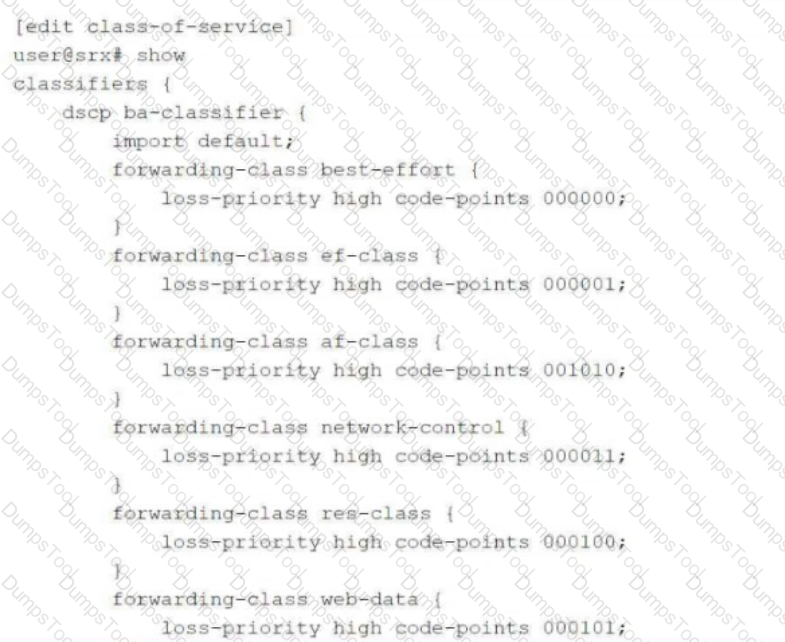
You have configured a CoS-based VPN that is not functioning correctly.
Referring to the exhibit, which action will solve the problem?
The SRX series device is performing static NAT. you want to ensure that host A can reach the
internal webserver www.juniper.net using domain name.

Referring to the exhibit, which two Junos features are required to accomplish this task? (Choose two.)
You want to bypass IDP for traffic destined to social media sites using APBR, but it is not working and IDP is dropping the session.
What are two reasons for this problem? (Choose two.)
Your IPsec tunnel is configured with multiple security associations (SAs). Your SRX Series device supports the CoS-based IPsec VPNs with multiple IPsec SAs feature. You are asked to configure CoS for this tunnel.
Which two statements are true in this scenario? (Choose two.)
You are asked to configure tenant systems.
Which two statements are true in this scenario? (Choose two.)
Which two statements are correct about the ICL in an active/active mode multinode HA environment? (Choose two.)
You Implement persistent NAT to allow any device on the external side of the firewall to
initiate traffic.
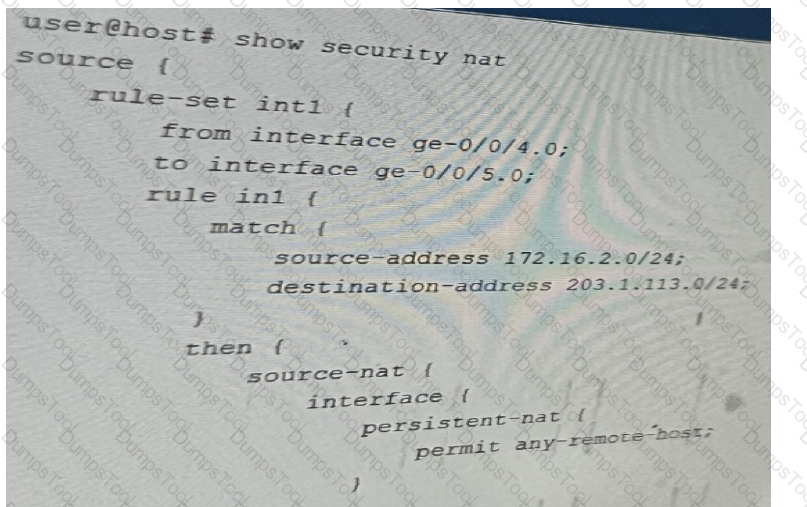
Referring to the exhibit, which statement is correct?
You are using ADVPN to deploy a hub-and-spoke VPN to connect your enterprise sites.
Which two statements are true in this scenario? (Choose two.)
Exhibit:
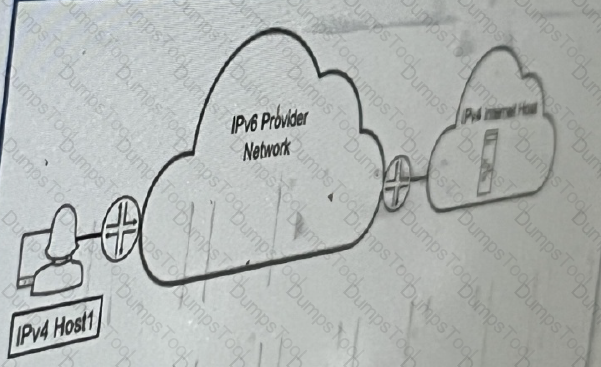
Referring to the exhibit, which technology would you use to provide communication between
IPv4 host1 and ipv4 internal host
Which two statements are true about the procedures the Junos security device uses when handling traffic destined for the device itself? (Choose two.)
You have deployed automated threat mitigation using Security Director with Policy Enforcer, Juniper ATP Cloud, SRX Series devices, Forescout, and third-party switches.
In this scenario, which device is responsible for communicating directly to the third-party switches when infected hosts need to be blocked?
You want to bypass IDP for traffic destined to social media sites using APBR, but it is not working and IDP is dropping the session.
What are two reasons for this problem? (Choose two.)
You are configuring an interconnect logical system that is configured as a VPLS switch to allow two logical systems to communicate.
Which two parameters are required when configuring the logical tunnel interfaces? (Choose two.)
Which two statements about transparent mode and Ethernet switching mode on an SRX series
device are correct.
You are configuring advanced policy-based routing. You have created a static route with next
hop of an interface in your inet.0 routing table
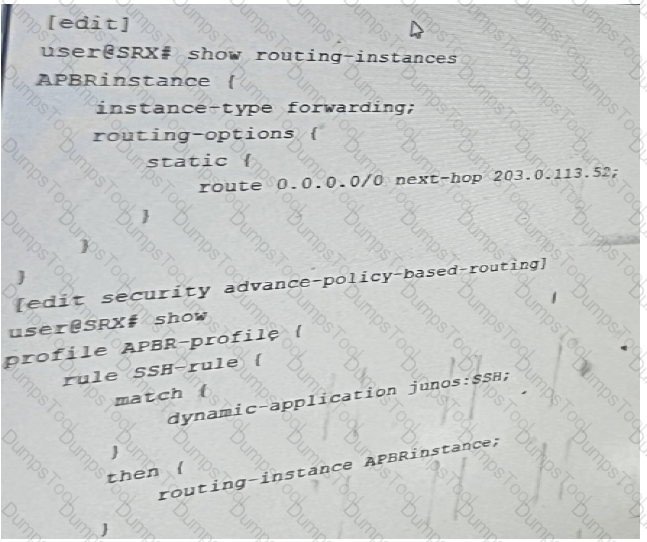
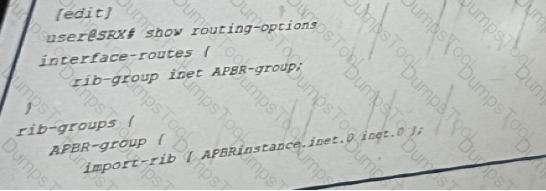
Referring to the exhibit, what should be changed to solve this issue?
Exhibit:
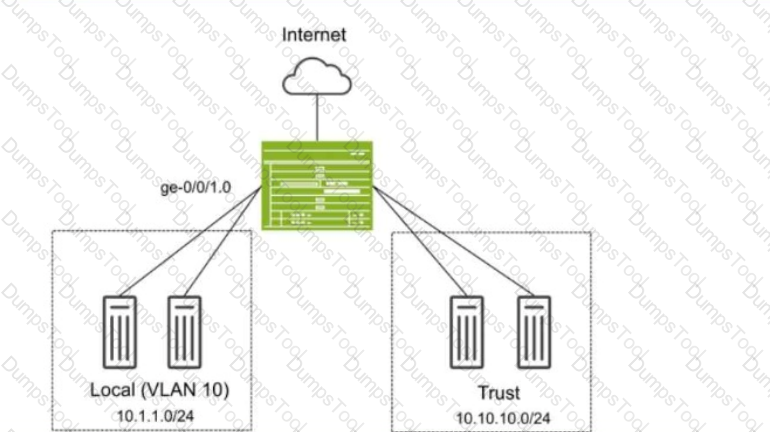
You have deployed an SRX Series device as shown in the exhibit. The devices in the Local zone have recently been added, but their SRX interfaces have not been configured. You must configure the SRX to meet the following requirements:
Devices in the 10.1.1.0/24 network can communicate with other devices in the same network but not with other networks or the SRX.
You must be able to apply security policies to traffic flows between devices in the Local zone.
Which three configuration elements will be required as part of your configuration? (Choose three.)
You want to create a connection for communication between tenant systems without using physical revenue ports on the SRX Series device.
What are two ways to accomplish this task? (Choose two.)
You are asked to create multiple virtual routers using a single SRX Series device. You must ensure that each virtual router maintains a unique copy of the routing protocol daemon (RPD) process.
Which solution will accomplish this task?
You are asked to establish a hub-and-spoke IPsec VPN using an SRX Series device as the hub. All of the spoke devices are third-party devices.
Which statement is correct in this scenario?
You have cloud deployments in Azure, AWS, and your private cloud. You have deployed
multicloud using security director with policy enforcer to. Which three statements are true in this scenario? (Choose three.)
Exhibit:
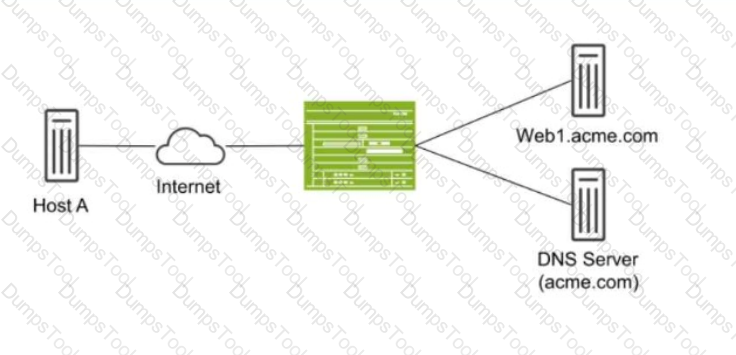
Host A shown in the exhibit is attempting to reach the Web1 webserver, but the connection is failing. Troubleshooting reveals that when Host A attempts to resolve the domain name of the server (web.acme.com), the request is resolved to the private address of the server rather than its public IP.
Which feature would you configure on the SRX Series device to solve this issue?
Exhibit:

Referring to the flow logs exhibit, which two statements are correct? (Choose two.)
Which two statements are true when setting up an SRX Series device to operate in mixed mode? (Choose two.)
You have deployed two SRX Series devices in an active/passive multimode HA scenario.
In this scenario, which two statements are correct? (Choose two.)
In a multinode HA environment, which service must be configured to synchronize between nodes?